Wideband Waveform Design for Distributed Precision Jamming
Abstract
1. Introduction
1.1. Related Work
1.2. Major Contributions
- Previous research on DIPJ based on a mathematical model of the narrowband signal is extended to a wideband signal to adapt it to a wider range of applications.
- A majorization minimization (MM) algorithm [31] is given for wideband jamming signal design based on the MTED objective. This type of optimization objective, based on the MTED between the jamming region and the protected region, has been widely used in previous studies of DIPJ [13,16,17,18]. However, it has the disadvantage of not being able to precisely control the jamming energy to remain high throughout in the target operating bandwidth, and we mainly use it for comparison with the desired power spectrum matching (DPSM) method.
- In order to better achieve precision jamming, we propose a jamming waveform design method based on DPSM. It firstly determines an approximate expected value of the power density to be matched on the basis of a simple semi-definite programming (SDP) problem. Then, a complete derivation and algorithmic complexity analysis are given for solving a nonconvex problem containing quartic terms using the MM algorithm, including a fast approximation for solving the maximum eigenvalue of the matrix.
- The results of the above algorithm are analyzed by simulating a typical DIPJ scenario. The quantitative results show that, compared with the method based on MTED, the DPSM method is able to design a wideband jamming waveform that is able to more accurately form a high-power focus in the jamming region over the entire bandwidth while suppressing power over the entire bandwidth of the protected region. However, compared with the previously inapplicable narrowband-based method, the MTED method can still be used for the wideband jamming waveform design of DIPJ, and it offers lower computational complexity than DPSM.
2. Wideband DIPJ Problem Formulation
3. Jamming Waveform Design Optimization Algorithm
3.1. Jamming Waveform Design with MTED
| Algorithm 1: MTED method |
| Input: |
| For p = −N/2 to N/2 − 1 |
| Initialize: |
| 1: Calculate according to |
| 2: Calculate according to . |
| 3: Calculate according to . |
| While converges threshold is not reached do |
| 4: Calculate according to Equation (22). |
| 5: z = z+1. |
| End while |
| End for |
| 6: Calculate according to Equation (24) |
3.2. Jamming Waveform Design with DPSM
3.2.1. Estimated Desired Power Spectrum
3.2.2. Mathematical Derivation of Algorithm
| Algorithm 2: DPSM method |
| Input:. |
| Initialize: |
| 1: Calculate according to Equations (26) and (27). |
| 2: Calculate according to Equation (33). |
| 3: While converges threshold is not reached do |
| 4: Calculate according to Equation (37). |
| 6: Calculate according to Equation . |
| 7: Calculate according to Equation (36). |
| 8: z = z+1. |
| 9: End while |
| Algorithm 3: MM Acceleration Strategy |
| Initialize:. |
| While MM algorithm does not achieve converges threshold do |
| 1: as the initial value and use DPSM algorithm for one iteration, and take the calculated result as . |
| 2: k = k+ 1. |
| if k < 3 go bank to step1 |
| else |
| 3: . |
| 4: . |
| 5: . |
| 6: |
| While use to calculate the value of the objective function in Equation (28), if it is greater than the value of the function calculated by do |
| 7: . |
| 8: |
| End while |
| 9: k = 0, z = z+ 1. |
| 10:. |
| 11:. |
| End while |
3.2.3. Acceleration Strategy
4. Simulation Verification and Results Discussion
4.1. Experimental Scenarios and Parameter Settings
4.2. Comparison of Different Algorithm Effects
4.3. Comparison of DSPM Method under Different Parameters
5. Conclusions
Author Contributions
Funding
Institutional Review Board Statement
Data Availability Statement
Conflicts of Interest
References
- You, S.; Diao, M.; Gao, L. Deep reinforcement learning for target searching in cognitive electronic warfare. IEEE Access 2019, 7, 37432–37447. [Google Scholar] [CrossRef]
- Lazarov, L. Perspectives and trends for the development of electronic warfare systems. In 2019 International Conference on Creative Business for Smart and Sustainable Growth (CREBUS), Sandanski, Bulgaria, 18–21 March 2019; IEEE: New York, NY, USA, 2019; pp. 1–3. [Google Scholar]
- Sharma, P.; Sarma, K.K.; Mastorakis, N.E. Artificial intelligence aided electronic warfare systems-recent trends and evolving applications. IEEE Access 2020, 8, 224761–224780. [Google Scholar] [CrossRef]
- Song, D.; Wang, W.; Xiong, Z.Y.; Xu, Z.H. Waveform diversity based regional energy focusing under ultra-sparse array. J. Electron. Inf. Technol. 2014, 36, 1082–1087. [Google Scholar]
- Strategic Technology Office (STO). Precision Electronic Warfare (PREW), DARPA-BAA 09-65; Strategic Technology Office (STO) of the US Defense Advanced Research Projects Agency: Arlington, VA, USA, 2009. [Google Scholar]
- Jiang, P. Study of development of precision EW technologies. Commun. Countermeas. 2010, 112, 3–6. [Google Scholar]
- Arafat, M.Y.; Moh, S. Localization and clustering based on swarm intelligence in UAV networks for emergency communications. IEEE Internet Things J. 2019, 6, 8958–8976. [Google Scholar] [CrossRef]
- Bai, L.; Chen, Q.; Bai, T.; Wang, J. UAV-Enabled Secure Multiuser Backscatter Communications With Planar Array. IEEE J. Sel. Areas Commun. 2022, 40, 2946–2961. [Google Scholar] [CrossRef]
- Bai, L.; Han, R.; Liu, J.; Yu, Q.; Choi, J.; Zhang, W. Air-to-ground wireless links for high-speed UAVs. IEEE J. Sel. Areas Commun. 2020, 38, 2918–2930. [Google Scholar] [CrossRef]
- Song, D.; Wang, W.; Xu, Z.; Xiong, Z.; Kirubarajan, T. Focused energy delivery with protection for precision electronic warfare. IEEE Trans. Aerosp. Electron. Syst. 2016, 52, 3053–3064. [Google Scholar] [CrossRef]
- Xia, X.; Zhu, P.; Li, J.; Wang, D.; Xin, Y.; You, X. Joint sparse beamforming and power control for a large-scale DAS with network-assisted full duplex. IEEE Trans. Veh. Technol. 2020, 69, 7569–7582. [Google Scholar] [CrossRef]
- Yan, J.; Li, J.; Zhao, L.; Chen, R. Robust joint transmit beamforming with QoS guarantees in time-asynchronous DAS. IEEE Trans. Veh. Technol. 2014, 64, 1506–1518. [Google Scholar] [CrossRef]
- Yang, Z.; Zhou, Q.; Li, Z.; Zhang, J.; Yang, S. Grating lobe suppression in focussed energy delivery for precision electronic warfare. IET Radar Sonar Navig. 2021, 15, 1420–1432. [Google Scholar] [CrossRef]
- Ozmen, N.; Dapp, R.; Zapf, M.; Gemmeke, H.; Ruiter, N.V.; van Dongen, K.W.A. Comparing different ultrasound imaging methods for breast cancer detection. IEEE Trans. Ultrason. Ferroelectr. Freq. Control. 2015, 62, 637–646. [Google Scholar] [CrossRef] [PubMed]
- Yang, Z.-P.; Yang, S.-N.; Zhou, Q.-S.; Zhang, J.-Y. Regional Focusing Irradiation of Low Sidelobe Array Based on ADMM. Acta Electonica Sin. 2021, 49, 1370. [Google Scholar]
- Chen, S.; Xu, C.; Zhang, J. Efficient focused energy delivery with grating lobe mitigation for precision electronic warfare. Signal Process. 2020, 169, 107409. [Google Scholar] [CrossRef]
- Yang, Z.-P.; Yang, S.-N.; Zhou, Q.-S.; Zhang, J.-Y.; Li, Z.-H.; Huang, Z.-R. A joint optimization algorithm for focused energy delivery in precision electronic warfare. Def. Technol. 2022, 18, 709–721. [Google Scholar] [CrossRef]
- Yang, Z.; Zhang, J.; Li, Z.; Zhou, Q.; Yang, S. Focused energy delivery with low grating lobes for precision electronic warfare via BCD framework. Electron. Lett. 2021, 57, 672–674. [Google Scholar] [CrossRef]
- Zhang, K.; Zhou, Q.; Wang, J.; Zhang, J.; Li, Z. A method for jamming waveform design in precision electronic warfare scenarios. IET Signal Process. 2022, 16, 562–574. [Google Scholar] [CrossRef]
- Boyd, S.; Boyd, S.P.; Vandenberghe, L. Convex Optimization; Cambridge University Press: Cambridge, UK, 2004. [Google Scholar]
- Zhu, S.; Yang, R.; Li, X.; Zuo, J.; Li, D.; Ding, Y. An optimizing method of OFDM radar communication and jamming shared waveform based on improved greedy algorithm. IEEE Access 2020, 8, 186462–186473. [Google Scholar] [CrossRef]
- Shi, C.G.; Wang, F.; Salous, S.; Zhou, J.J. Adaptive jamming waveform design for distributed multiple-radar architectures based on low probability of intercept. Radio Sci. 2019, 54, 72–90. [Google Scholar] [CrossRef]
- Gao, J.; Wu, R.; Zhang, J. An adaptive multi-target jamming waveform design based on power minimization. Entropy 2020, 22, 508. [Google Scholar] [CrossRef]
- Xu, Y.; Wang, C.; Liang, J.; Yue, K.; Li, W.; Zheng, S.; Zhao, Z. Deep Reinforcement Learning Based Decision Making for Complex Jamming Waveforms. Entropy 2022, 24, 1441. [Google Scholar] [CrossRef]
- Li, Z.; Shi, J.; Liu, W.; Pan, J.; Li, B. Robust joint design of transmit waveform and receive filter for MIMO-STAP radar under target and clutter uncertainties. IEEE Trans. Veh. Technol. 2021, 71, 1156–1171. [Google Scholar] [CrossRef]
- Zheng, K.; Zhao, L.; Mei, J.; Shao, B.; Xiang, W.; Hanzo, L. Survey of large-scale MIMO systems. IEEE Commun. Surv. Tutor. 2015, 17, 1738–1760. [Google Scholar] [CrossRef]
- Gemechu, A.Y.; Cui, G.; Yu, X. Spectral-compatible transmit beampattern design with minimum peak sidelobe for narrowband MIMO radar. IEEE Trans. Veh. Technol. 2022, 71, 11900–11910. [Google Scholar] [CrossRef]
- He, H.; Stoica, P.; Li, J. Wideband MIMO systems: Signal design for transmit beampattern synthesis. IEEE Trans. Signal Process. 2010, 59, 618–628. [Google Scholar] [CrossRef]
- Yu, X.; Cui, G.; Yang, J.; Kong, L.; Li, J. Wideband MIMO radar waveform design. IEEE Trans. Signal Process. 2019, 67, 3487–3501. [Google Scholar] [CrossRef]
- Yu, X.; Cui, G.; Yang, J.; Kong, L. MIMO radar transmit–receive design for moving target detection in signal-dependent clutter. IEEE Trans. Veh. Technol. 2019, 69, 522–536. [Google Scholar] [CrossRef]
- Sun, Y.; Babu, P.; Palomar, D.P. Majorization-minimization algorithms in signal processing, communications, and machine learning. IEEE Trans. Signal Process. 2016, 65, 794–816. [Google Scholar] [CrossRef]
- Tang, B.; Liang, J. Efficient algorithms for synthesizing probing waveforms with desired spectral shapes. IEEE Trans. Aerosp. Electron. Syst. 2018, 55, 1174–1189. [Google Scholar] [CrossRef]
- Tang, Y.; Zhang, Y.D.; Amin, M.G.; Sheng, W. Wideband multiple-input multiple-output radar waveform design with low peak-to-average ratio constraint. IET Radar Sonar Navig. 2016, 10, 325–332. [Google Scholar] [CrossRef]
- Grant, M.; Boyd, S. CVX: Matlab Software for Disciplined Convex Programming, version 2.1; CVX Research, Inc.: Austin, TX, USA, 2014. [Google Scholar]
- Song, J.; Babu, P.; Palomar, D.P. Sequence design to minimize the weighted integrated and peak sidelobe levels. IEEE Trans. Signal Process. 2015, 64, 2051–2064. [Google Scholar] [CrossRef]
- Varadhan, R.; Roland, C. Simple and globally convergent methods for accelerating the convergence of any EM algorithm. Scand. J. Stat. 2008, 35, 335–353. [Google Scholar] [CrossRef]
- Zhang, K.; Wang, J.; Zhou, Q.; Zhang, J. Jamming Waveform Designed in Focused Energy Delivery for Precision Electronic Warfare Scenario. In 2022 7th International Conference on Intelligent Computing and Signal Processing (ICSP), Xi’an, China, 15–17 April 2022; IEEE: New York, NY, USA, 2022; pp. 1382–1386. [Google Scholar]
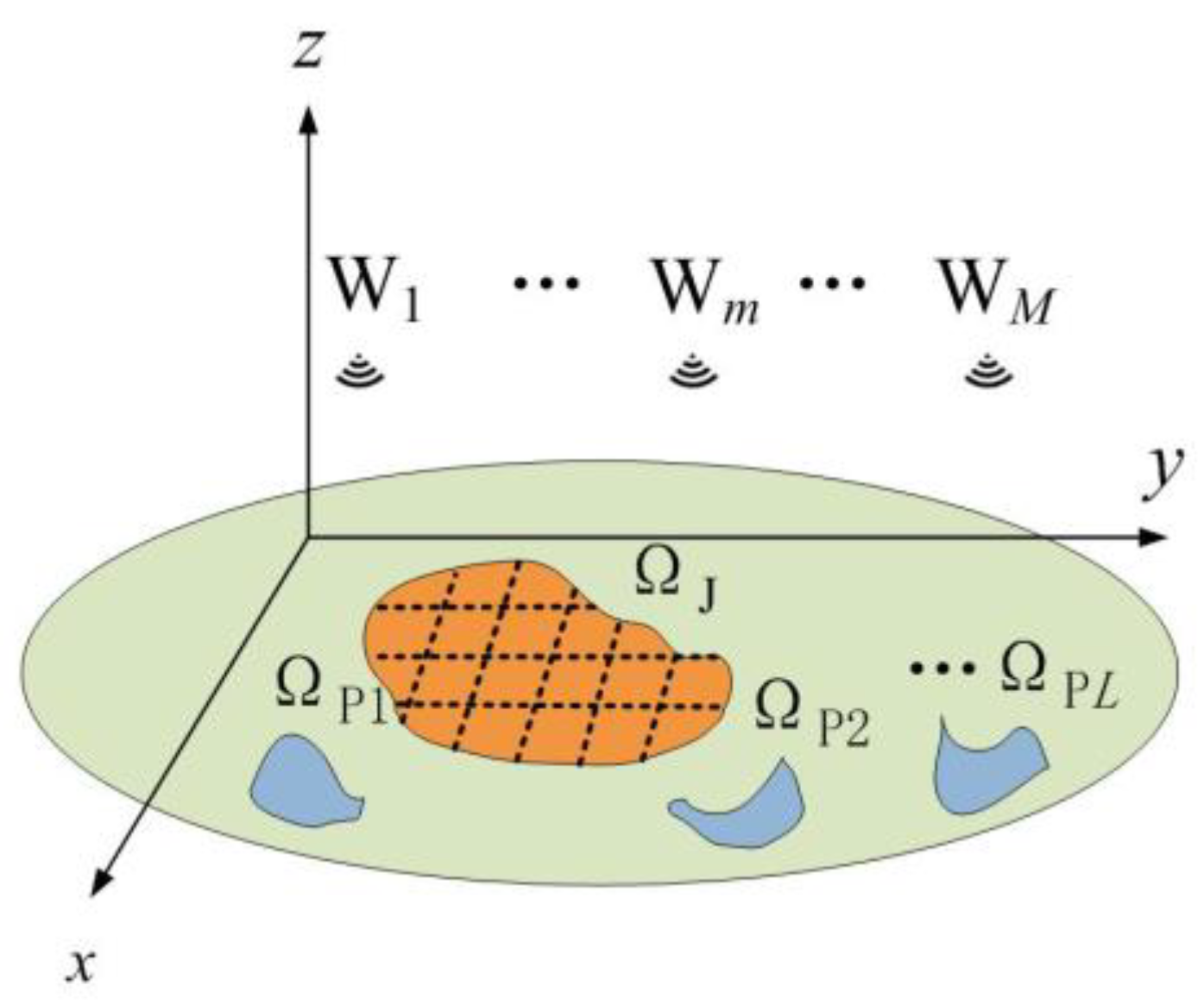

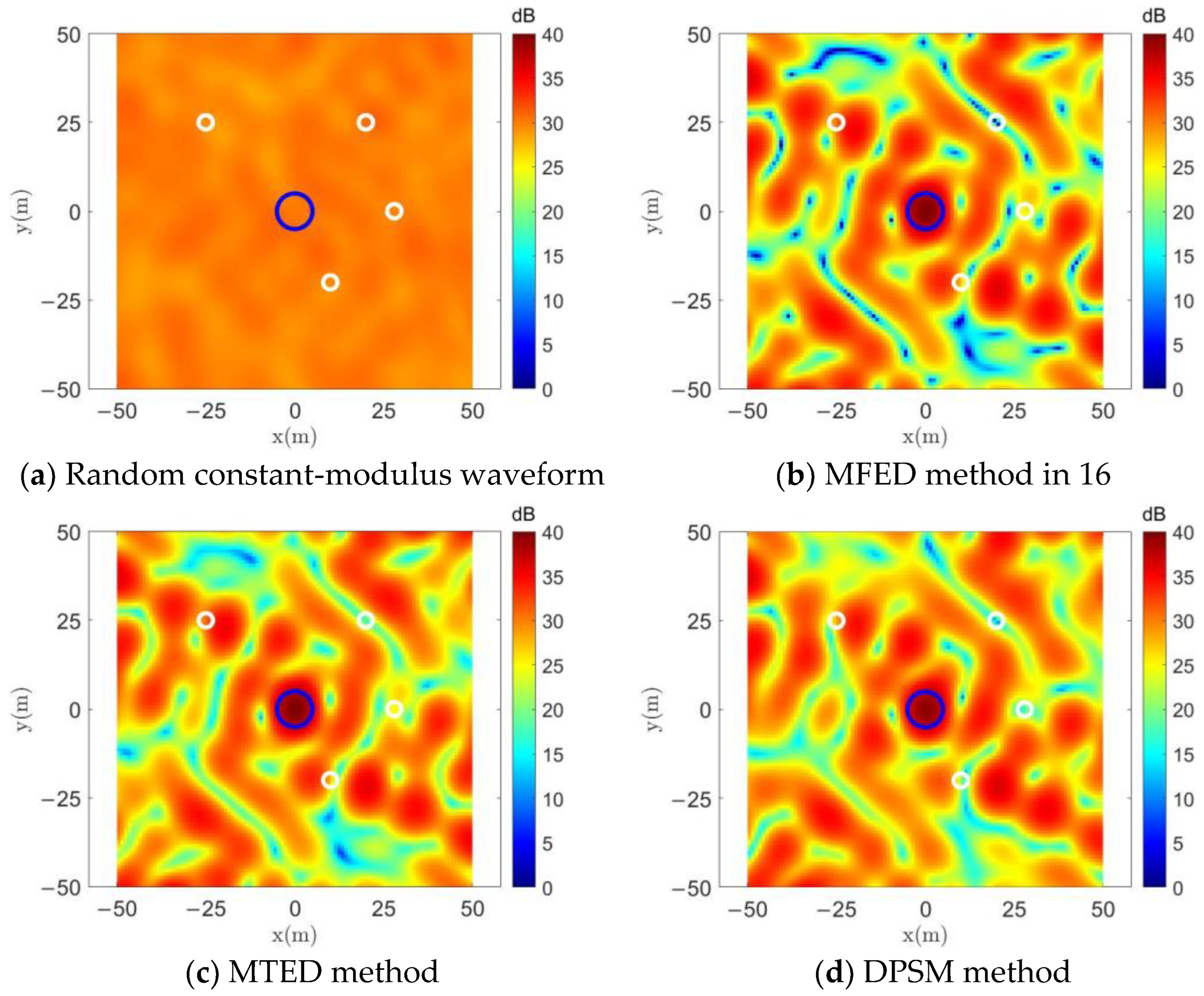
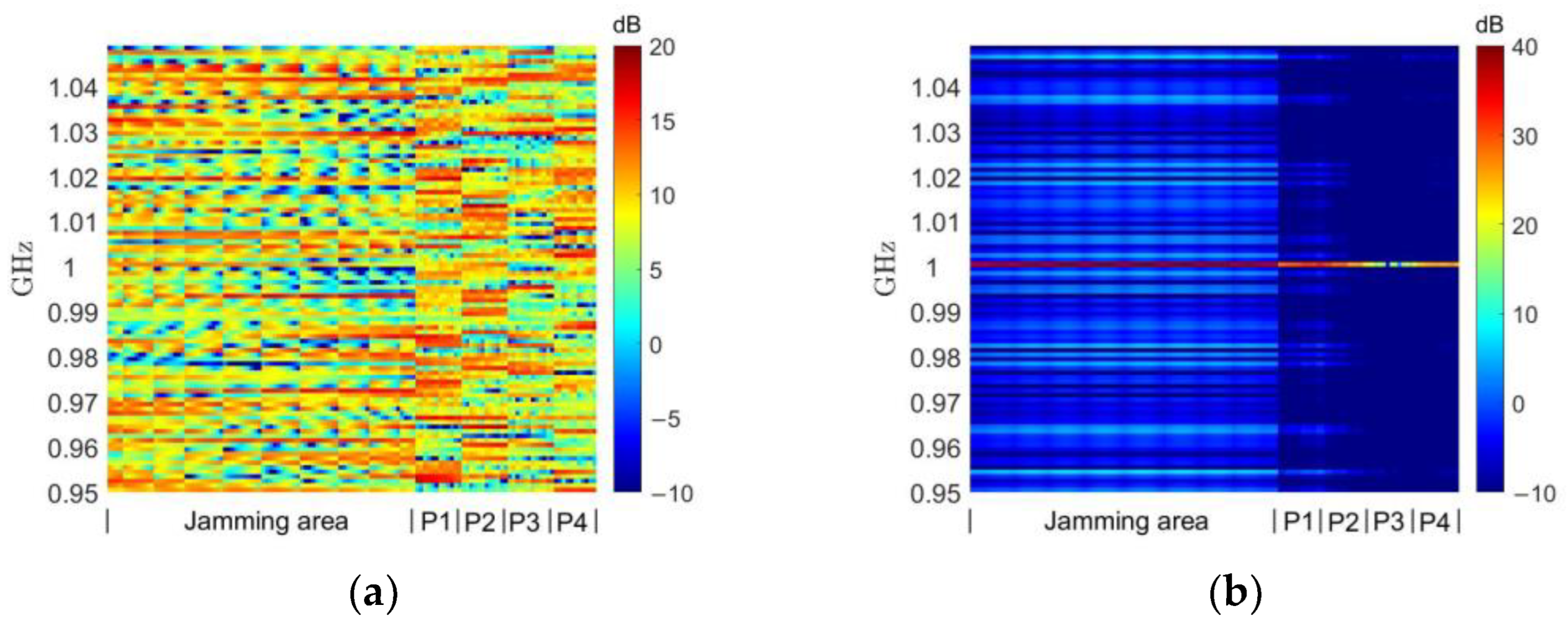


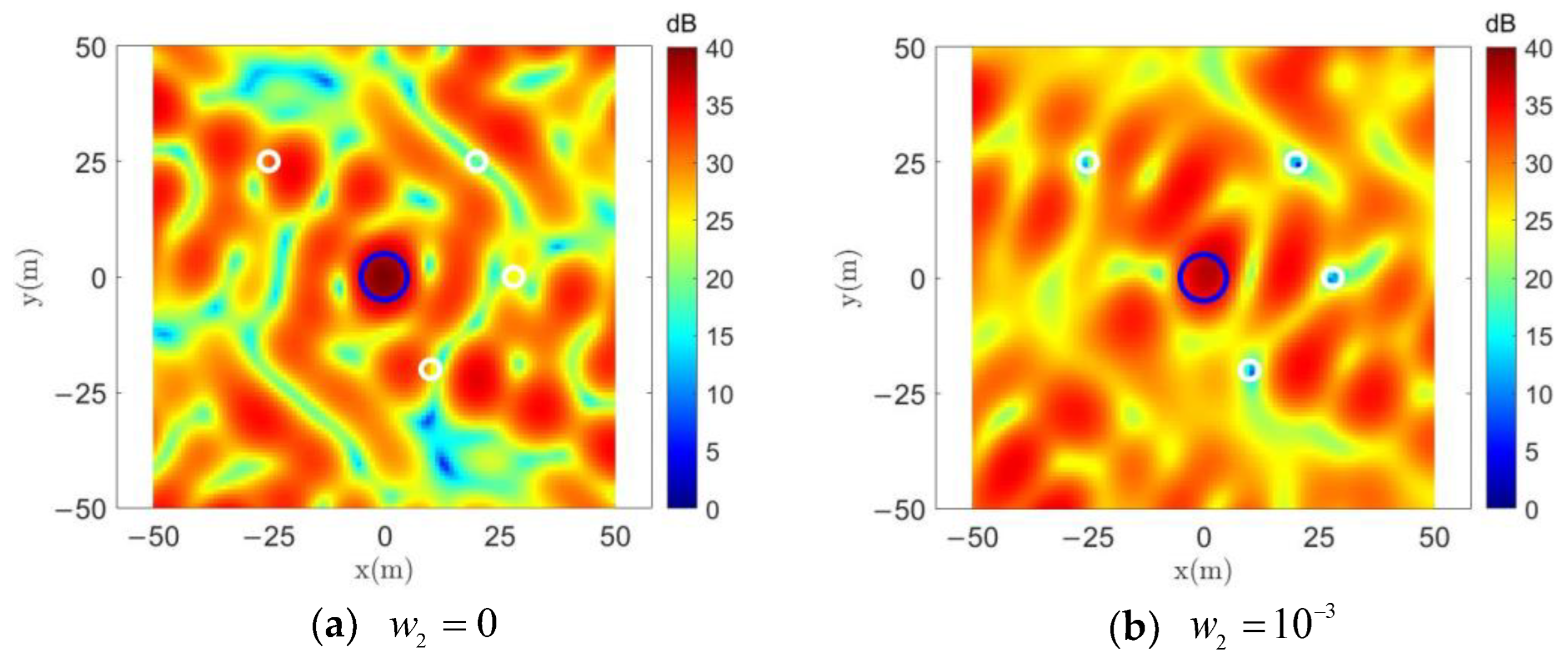
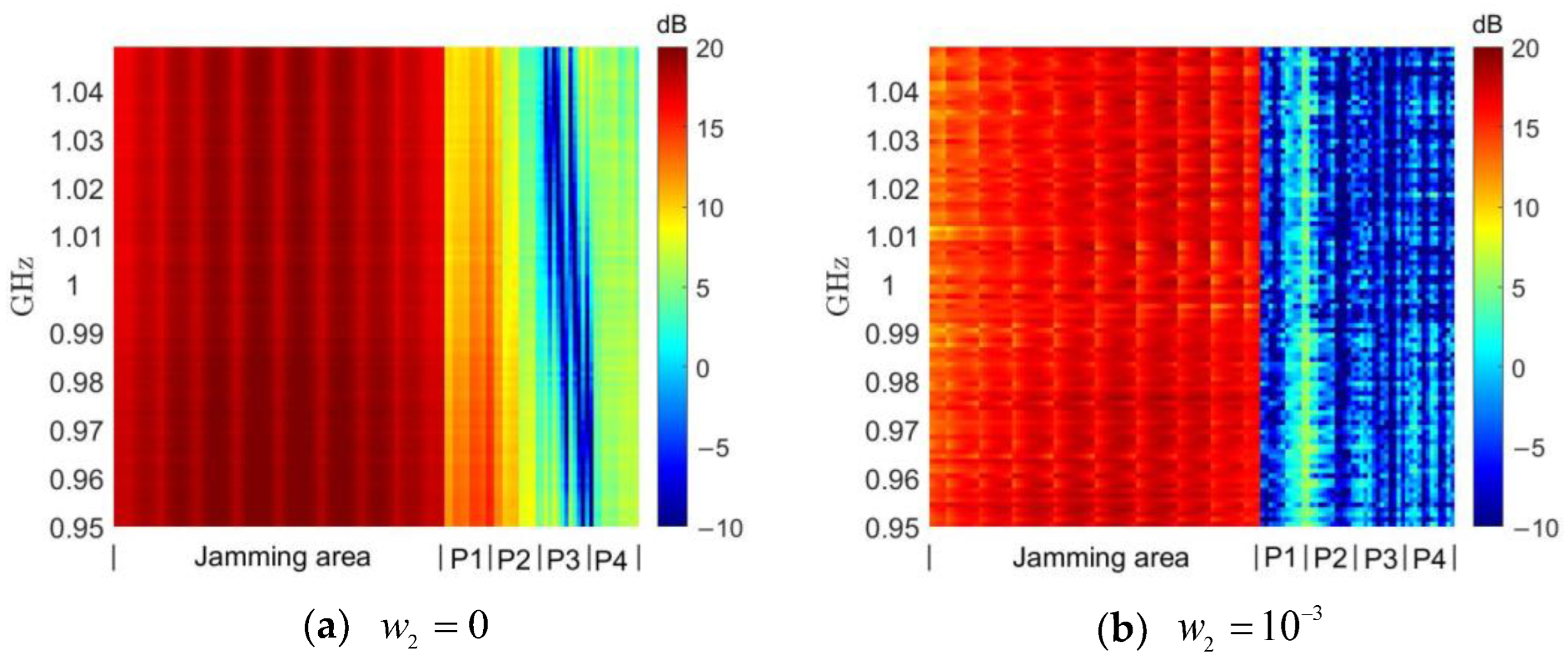
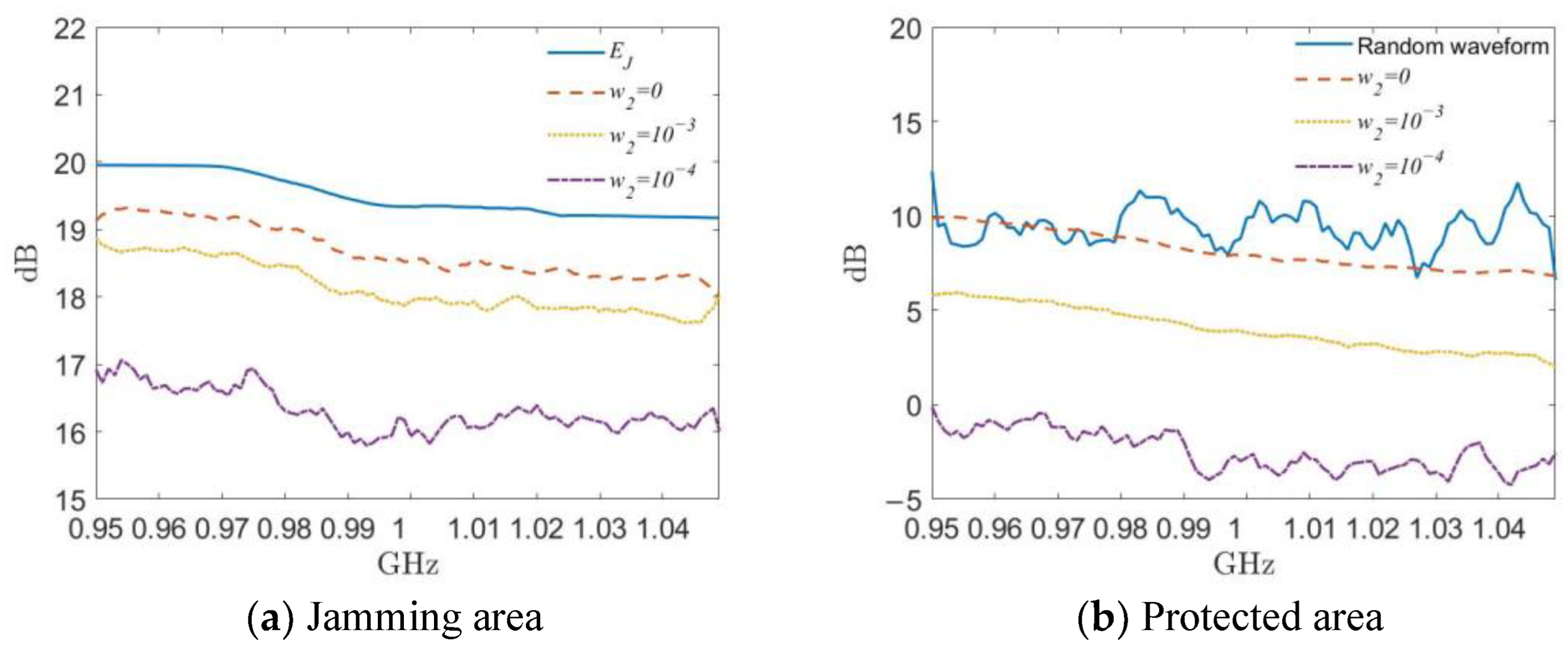
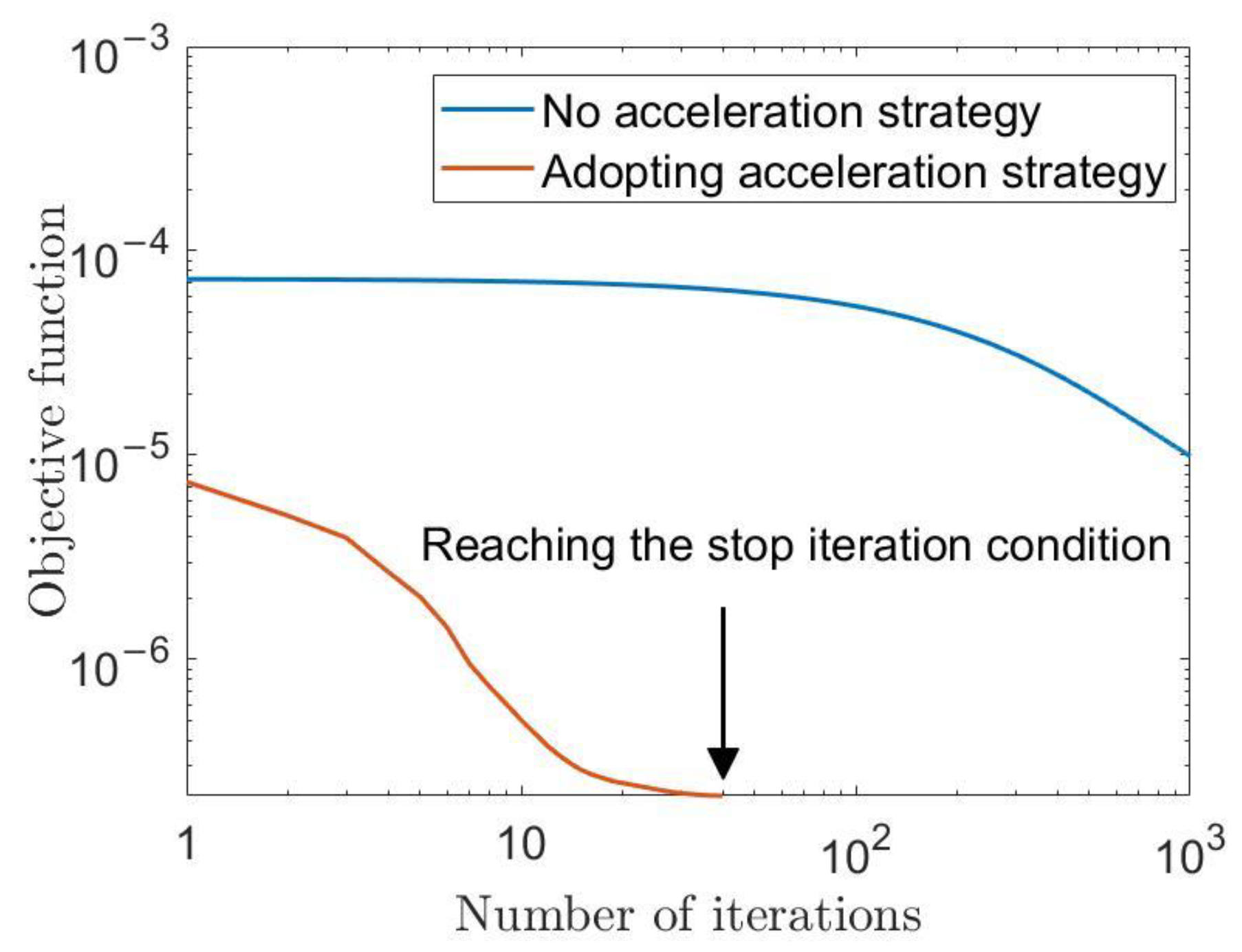

| M | N | MTED | DPSM |
|---|---|---|---|
| 10 | 50 | 0.3 s | 0.8 s |
| 100 | 1.7 s | 4.3 s | |
| 150 | 4.7 s | 9.4 s | |
| 200 | 10.1 s | 23.2 s | |
| 5 | 100 | 0.7 s | 1.1 s |
| 15 | 3.1 s | 6.4 s | |
| 20 | 4.9 s | 10.8 s |
Disclaimer/Publisher’s Note: The statements, opinions and data contained in all publications are solely those of the individual author(s) and contributor(s) and not of MDPI and/or the editor(s). MDPI and/or the editor(s) disclaim responsibility for any injury to people or property resulting from any ideas, methods, instructions or products referred to in the content. |
© 2023 by the authors. Licensee MDPI, Basel, Switzerland. This article is an open access article distributed under the terms and conditions of the Creative Commons Attribution (CC BY) license (https://creativecommons.org/licenses/by/4.0/).
Share and Cite
Zhang, K.; Zhou, Q.; Wang, J.; Huang, C.; Yang, Z.; Zhang, J. Wideband Waveform Design for Distributed Precision Jamming. Entropy 2023, 25, 496. https://doi.org/10.3390/e25030496
Zhang K, Zhou Q, Wang J, Huang C, Yang Z, Zhang J. Wideband Waveform Design for Distributed Precision Jamming. Entropy. 2023; 25(3):496. https://doi.org/10.3390/e25030496
Chicago/Turabian StyleZhang, Kedi, Qingsong Zhou, Jing Wang, Chao Huang, Zhongping Yang, and Jianyun Zhang. 2023. "Wideband Waveform Design for Distributed Precision Jamming" Entropy 25, no. 3: 496. https://doi.org/10.3390/e25030496
APA StyleZhang, K., Zhou, Q., Wang, J., Huang, C., Yang, Z., & Zhang, J. (2023). Wideband Waveform Design for Distributed Precision Jamming. Entropy, 25(3), 496. https://doi.org/10.3390/e25030496





